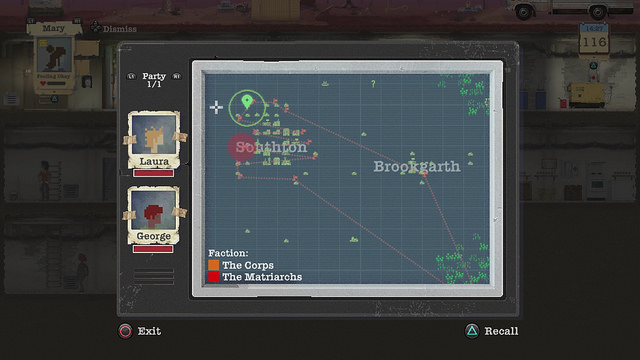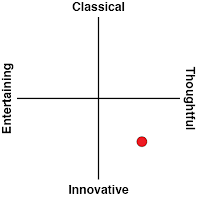Review by Jim S.
Ever wonder what it would be like for you and your family to survive a post-apocalyptic world in an underground shelter? In Sheltered, you do just that.
Related reading: This plays a little like a premium version of Bethesda’s Free-to-Play Fallout Shelter. Lindsay’s review of that game here.
Sheltered lets you make a family of your liking (including same-sex couples – good to see!), so you end up with two adults and two children. You will also be able to pick a family pet, there are a few to pick from – each of which will help the family survive in their own way, from fish and cats that will help to relieve stress through to dogs that will help to fight off invaders. Each family member will also have personality types. Some are smarter for trading, while others will be of better help once a fight breaks out. Finally, each character will also have a negative. My son, for example, was a big eater and would need to eat more than others to be full.
Once created, the family will jump into a shelter that protects them from the apocalyptic elements outside. The game will start a short tutorial giving you the basics of how to survive in this world. You start with one small food pantry with a little bit of food, a generator for keeping everything running with power, and a water butt for keeping water. Some of the things that run off the generator are an oxygen filter that keeps the air clean and a water filter for keeping water drinkable, and you can also build things later that also run off the generator like a freezer for keeping meat fresh. The generator needs fuel to run and to get fuel you must send a party out of the shelter to look for goods.
To set up an expedition you must have one of the family members use the radio and from there you will pick one or two of the survivors to take out and then you equip them with weapons and goods for the trip. Weapons need a certain amount of strength stat to use but you can build strength by training your chosen warriors at home. After equipping the party you are brought to a map where you select where you would like them to go. When you first start there will be question marks on the map showing the places you haven’t explored yet.
When out in the wasteland you will sometimes come across other survivors who will ask to either join your shelter, ask to trade, or try to attack you. You will sometimes cross paths with wild animals. Animals will attack you and you will have to fight or flee. Combat is turn based with options to let you attack, flee, use an item or subdue. If you win a combat animals will drop leather and meat while humans will drop items that can be useful. After an encounter is resolved the party will continue their expedition. Once they are near a place of interest they will radio back asking if you would like them to search and they will radio back once again to let you know what they found this will bring up an inventory of space your party has to carry and what they found at their current location.
Once the expedition is over the party will return to the shelter they will almost always be dirty, hungry, and tired. I learned the hard way that eating while dirty will sometimes give you food poising. Food poising is not fun as that person will throw up all over the shelter for a time before they are healed. Having a dirty shelter can invite rats into your shelter and will potentially make everyone else sick. Shelter members all have needs much like the people in The Sims games and you must tell them when to use the restroom, eat, drink, and shower. You can also set it to automatically take care of themselves but that can lead to running out of food or water faster than you would like, because when they are AI controlled they seems to lose any concept of how important it is to conserve resources through an apocalypse.
As all the above should show, there are a lot of balls in the air to juggle in Sheltered if you’re trying to keep your people alive, and that’s how it really should be for an apocalyptic setting. And, because there are so many mechanics at play at once, something fascinating starts to happen – you start to see your characters less as people to save, and more as resources. Where a game like The War of Mine really works hard to humanise the whole experience of trying to survive something horrific, Sheltered is more cut-and-dry about its morality, and that’s perhaps more like what we can expect in the event of a real apocalypse. So people become vital cogs in a survival factory line, each with their own specific tasks, and because there are so few of them, there’s not really any room to double up or have backups. And that’s why each character’s death is so distressing – it’s the loss of a major cog in the machine, and one that might well spell doom for everyone else.
Or perhaps there is some connection that we build with our characters, despite utilising them as resources as we play. I’ll highlight that with a story; when a member dies there is no getting them back, as the game autosaves a lot so even a loading a new save won’t save them. The first person in my family to die was my daughter – a sweet little girl who was out on an expedition with her father when they got attacked by two women. The women targeted her for some reason; perhaps she was going for the weakest first. My poor little girl bled to death once I got her back to the shelter and there was nothing I could do. I started to wonder what I could do differently that might have saved her but it was too late. I couldn’t just leave her dead body on the shelter floor and I had a few options of what to do. I could harvest her body and get meat – yes, that is an option – but there was no way I was going to turn to cannibalism. I can burn her body but I would have to build an incinerator for that. I decided to craft a grave and bury her outside near our shelter hatch. I loved how this game made me think about how I could have saved her but the hopelessness of knowing now that she was gone there was nothing I could do to bring her back. So, even though I did use her as a resource while she was alive, she stopped being that once she died. Perhaps there’s some commentary in there about how we live our lives day-to-day as well.
Lots of random things can happen in the shelter. I have had traders come to my shelter and had people look for a safe place and join my group of survivors. I have had to decline to let most of them in sadly as finding the things we need to survive is hard and having another mouth to feed wasn’t going to help matters. I have had one person break into my shelter to steal food. I didn’t have any traps set but I did have a few hiding spots so I hid the family and let them take the food they wanted. After they left I did some repairs of the doors they broke down and crafted a shotgun trap. The next person that tries breaking in wasn’t so lucky. I have also had a guy come looking for food and threatening that if we didn’t share something bad might happen. I refused to give him any and he would leave and on his way out damage the oxygen filter or water filter. He would come back again every few days asking for food and I always refused him. It seemed the only way to stop this was to actually kill him. I didn’t do this though and he ended up leaving me alone after some time – I like to think someone else got to him before I did.
Sheltered is like a premium version of Fallout Shelter, and it’s a far more thematically compelling proposition. I love that it makes you be quite ruthless in your efforts to keep your family alive, but then allows you to feel awful when they die. It’s less humanising than The War of Mine, which is the most readily comparable game out there at the moment, but it’s intense for its own, valuable, reasons.
– Jim S.
Contributor











